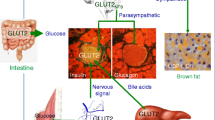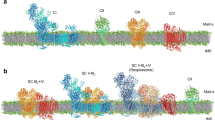Abstract
Protein composition in different segments along nerves from rats intoxicated with 2,5-hexanedione (HD) was analyzed by sodium dodecyl sulfate polyacrylamide gel electrophoresis and by immunoblotting, using monoclonal antibodies specific for each of the three neurofilament polypeptide components (H, M, and L). Comparison with nerve protein extracts from normal (control) rats revealed a disappearance of the largest neurofilament polypeptide (H), accompanied by accumulation of higher-molecular-weight products that were immunoreactive with H-specific antibodies. Both the extent of this crosslinking and its localization in particular portions of peripheral nerves showed a correlation with HD dosage and with the known progression of ultrastructural features during HD-induced neuropathy. Similar changes were not detected for the M and L neurofilament components.
Similar content being viewed by others
References
Anthony D. C., Boekelheide N. A., Anderson C. W., and Graham D. G. (1983a) The effect of 3,4-dimethyl substitution on the neurotoxicity of 2,5-hexanedione. II. Dimethyl substitution accelerates pyrrole formation and protein crosslinking.Toxicol. Appl. Pharmacol. 71, 372–382.
Anthony D. C., Boekelheide N. A., and Graham D. G. (1983b) The effect of 3,4-dimethyl substitution on the neurotoxicity of 2,5-hexanedione. I. Accelerated clinical neuropathy is accompanied by more proximal axonal swellings.Toxicol. Appl. Pharmacol. 71, 362–371.
Carden M. J. and Eagles P. A. M. (1983) Neurofilaments from ox spinal nerves. Isolation, disassembly, reassembly and cross-linking properties.Biochem. J. 215, 227–237.
Carden M. J. and Eagles P. A. M. (1986) Chemical cross-linking of ox neurofilaments.Biochem. J. 234, 587–591.
Carden M. J., Schlaepfer W. W., and Lee V. M-Y. (1985) The structure, biochemical properties, and immunogenicity of neurofilament peripheral regions are determined by phosphorylation state.J. Biol. Chem. 260, 9805–9817.
Cavanagh J. B. and Bennetts R. J. (1981) On the pattern of changes in the rat nervous system produced by 2,5-hexanediol.Brain 104, 297–318.
Chin T-K., Eagles P. A. M., and Maggs A. M. (1983) The proteolytic digestion of ox neurofilaments with trypsin and chymotrypsin.Biochem. J. 215, 239–252.
Couri D. and Milks M. M. (1982) Toxicity and metabolism of the neurotoxic hexacarbonsn-hexane, 2-hexanone and 2,5-hexanedione.Ann. Rev. Pharmacol. Toxicol. 22, 145–166.
Couri D. and Milks M. M. (1985) Hexacarbon neurotoxicity: Tracking a toxin.Neurotoxicology 6, 65–72.
DeCaprio A. P., Olajos E. J., and Weber P. (1982) Covalent binding of a neurotoxicn-hexane metabolite: Conversion of primary amines to substituted pyrrole adducts by 2,5-hexanedione.Toxicol. Appl. Pharmacol. 65, 440–450.
DeCaprio A. P. and O’Neill E. A. (1985) Alterations in rat axonal cytoskeletal protein induced by in vitro and in vivo 2,5-hexanedione exposure.Toxicol. Appl. Pharmacol. 78, 235–247.
DiVicenzo G. D., Kaplan C. J., and Dedinas J. (1976) Characterization of the metabolites of methyln-butyl ketone, methyl iso-butyl ketone, and methyl ethyl ketone in guinea pig serum and their clearance.Toxicol. Appl. Pharmacol. 36, 511–522.
Dyck P. J., Thomas P. K., Lambert E. H., and Bunge R. (eds.) (1984)Peripheral Neuropathy, 2nd ed., W. B. Saunders, Philadelphia, PA.
Geisler N., Fischer S., Vanderkerckhove J., VanDamme J., Plessmann U., and Weber K. (1985) Protein-chemical characterization of NF-H, the largest mammalian neurofilament component; Intermediate filament-type se quences followed by a unique carboxy-terminal extension.EMBO J. 3, 2701–2706.
Graham D. G. and Abou-Donia M. B. (1980) Studies on the molecular pathogenesis of hexane neuropathy. I. Evaluation of the inhibition of glyceraldehyde-3-phosphate dehydrogenase by 2,5-hexanedione.J. Toxicol. Environ. Health 6, 623–631.
Graham D. G., Anthony D. C., Boekelheide K., Maschmann N. A., Richards R. G., Wolfram J. W., and Ramsay-Shaw B. (1982) Studies on the molecular pathogenesis ofn-hexane neuropathy. II. Evidence that pyrrole derivatization of lysyl residues leads to protein cross-linking.Toxicol. Appl. Pharmacol. 64, 415–422.
Graham D. G., Anthony D. C., Szakal-Quin G., Gottfried M. R., and Boekelheide K. (1985) Covalent crosslinking of neurofilaments in the pathogenesis ofn-hexane neuropathy.Neurotoxicology 6, 55–64.
Graham D. G., Szakal-Quin G., Priest J. W., and Anthony D. C. (1984) In vitro evidence that covalent crosslinking of neurofilaments occurs in gamma-diketone neuropathy.Proc. Natl. Acad. Sci. USA 81, 4979–4982.
Griffin J. W., Fahnestock K. E., Price D. L., and Cork L. C. (1983) Cytoskeletal disorganization induced by local application of beta, beta′-iminodiproprionitrile and 2,5-hexanedione.Ann. Neurol. 14, 55–61.
Gonzales E. G. and Downey J. A. (1972) Polyneuropathy in a glue sniffer.Arch. Phys. Med. Rehabil. 53, 333–337.
Herskowitz A., Ishii N., and Schaumburg H. (1971)N-hexane neuropathy: A syndrome occurring as a result of industrial exposure.New Engl. J. Med. 285, 82–85.
Hoffman P. N. and Lasek R. J. (1975) The slow component of axonal transport: Identification of major structural polypeptides of the axon and their generality among mammalian neurons.J. Cell Biol. 66, 351–366.
Julien J-P. and Mushynski W. E. (1983) The distribution of phosphorylation sites among identified proteolytic fragments of mammalian neurofilaments.J. Biol. Chem. 258, 4019–4025.
Korobkin R., Asbury A. K., Sumner A. J., and Nielsen S. L. (1975) Glue-sniffing neuropathy.Arch. Neurol. 32, 158–162.
Krasavage W. J., O’Donoghue J. L., DiVincenzo G. D., and Terhaar C. J. (1980) The relative neurotoxicity of methyln-butyl ketone,n-hexane and their metabolites.Toxicol. Appl. Pharmacol. 52, 433–441.
Lapadula D. M., Irwin R. D., Suwita E., and Abou-Donia M. B. (1986) Cross-linking of neurofilament proteins of rat spinal cord in vivo after administration of 2,5-hexanedione.J. Neurochem. 46, 1843–1850.
Lee V. M-Y., Wu H-S., and Schlaepfer W. W. (1982) Monoclonal antibodies recognize individual neurofilament triplet proteins.Proc. Natl. Acad. Sci. USA 79, 6089–6092.
Lee V. M-Y., Carden M. J., and Trojanowski J. Q. (1986) Novel monoclonal antibodies provide evidence for thein situ existence of a nonphosphorylated form of the largest neurofilament subunit.J. Neurosci. 6, 850–858.
Mendell J. R., Saida K., Ganasia M. F., Jackson D. B., Weiss H. S., Gardier R. W., Christman C., Allen N., Couri D., O’Neill J., Marks C., and Hetland L. (1974) Toxic polyneuropathy produced by methyl n-butyl ketone.Science 185, 787–789.
Monaco S., Autilio-Gambetti L., Zabel D., and Gambetti P. (1985) Giant axonal neuropathy: Accelerations of neurofilament transport in optic axons.Proc. Natl. Acad. Sci. USA 82, 920–924.
Sahenk Z. and Mendell J. (1983) Studies on the morphological alterations of axonal membranous organelles in neurofilamentous neuropathies.Brain Res. 268, 239–247.
Sayre L. M., Autilio-Gambetti L., and Gambetti P. (1985) Pathogenesis of experimental giant neurofilamentous axonopathies: A unified hypothesis based on chemical modification of neurofilaments.Brain Res. Rev. 10, 69–83.
Schlaepfer W. W. and Freeman L. A. (1978) Neurofilament proteins of rat peripheral nerve and spinal cord.J. Cell Biol. 78, 653–662.
Shirabe T., Tsuda T., Terao T., and Araki S. (1974) Toxic polyneuropathy due to glue-sniffing.J. Neurol. Sci. 21, 101–113.
Spencer P. S. and Schaumburg H. H. (1975) Experimental neuropathy produced by 2,5-hexanedione—a major metabolite of the neurotoxic solvent methyln-butyl ketone.J. Neurol. Neurosurg. Psychiatry,33, 771–775.
Spencer P. S. and Schaumburg H. H. (1977) Ultrastructural studies of the dying-back process. III. The evolution of experimental peripheral giant axonal degeneration.J. Neuropathol. Exp. Neurol. 36, 276–299.
Towfighi J., Gonatas N. K., Pleasure D., Cooper H. S., and McCree L. (1976) Glue sniffer’s neuropathy.Neurology 26, 238–243.
Trojanowski J. Q., Obrocka M., and Lee V. M-Y. (1985) Distribution of bovine neurofilament subunits in neurons and neuronal processes. Immunohistochemical studies of bovine cerebellum with subunit specific monoclonal antibodies.J. Histochem. Cytochem. 33, 557–563.
Willard M. and Simon C. (1981) Antibody decoration of neurofilaments.J. Cell Biol. 89, 198–205.
Zagoren J. C., Politis M. J., and Spencer P. S. (1983) Rapid reorganization of the axonal cytoskeletal induced by gamma-diketone.Brain Res. 270, 162–164.
Author information
Authors and Affiliations
Additional information
Author to whom all correspondence and reprint requests should be addressed.
Rights and permissions
About this article
Cite this article
Carden, M.J., Lee, V.M.Y. & Schlaepfer, W.W. 2,5-Hexanedione neuropathy is associated with the covalent crosslinking of neurofilament proteins. Neurochemical Pathology 5, 25–35 (1986). https://doi.org/10.1007/BF03028034
Received:
Accepted:
Issue Date:
DOI: https://doi.org/10.1007/BF03028034




